Zem2all ProjectMiscellaneous
Rafael del Río
Manager
Electric Cars Business & Ralliart
MMC Automóviles Spain.
Official Distributor Mitsubishi Motors Corporation
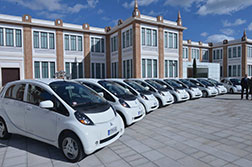
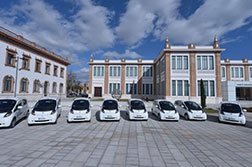
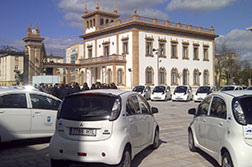
In January this year, Malaga city council received a consignment of twenty electric cars. The delivery completed a series of shipments of Mitsubishi i-MiEV vehicles included in the Zem2all project.
Project overview
Zem2all is an acronym for Zero Emissions Mobility to All. With a planned total investment of 65 million EUR, it is the largest electric-car project in the world. Most of the funding comes from the Japanese government, and the Spanish Department of Industry also contributes through the CDTI, Spain's Centre for Industrial Technology Development. A consortium of Japanese and Spanish firms is in charge of running the operations. The additional services needed to complete each of the project's “working packs” are provided by global leaders in their respective fields. These include MAPFRE, which was called on by Mitsubishi Heavy Industries and Mitsubishi Corporation to join in the project as an insurance provider.
The benefits of electric cars
The general public is at a loss as to why companies, particularly in the automotive industry, take electric cars so seriously, when they do not look likely to replace standard cars altogether any time soon. Environmental reasons spring to mind, though they do not appear compelling enough to outweigh consumer inertia and get people to recharge their cars at night for their daily commute. Sensitivity to green issues is not yet sufficiently developed to change ingrained habits. So it will actually be economic, political and efficiency reasons that will bring electric cars much sooner than we imagine. For example, travelling 100 km in an electric car typically costs less than 2 EUR. This price is not explained by circumstantial factors but by efficiency. And efficiency almost invariably entails financial benefits. Using electricity to drive a car is far more efficient than using fossil fuel.
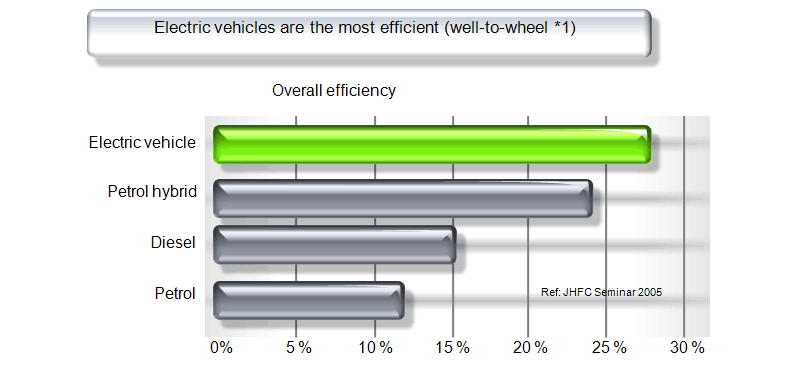
Figure 1: Overall energy efficiency
*1: Overall efficiency throughout the energy lifecycle: from extraction to application on the vehicle's wheels to drive it.
Source: JHFC Seminar 2005.
Mule-tractor comparison and analogy
A tractor will plough a field much more efficiently than a mule, but the farmers of yesteryear no doubt faced a similar quandary to today's consumers when it comes to adopting new technologies. In the past, there were pastures aplenty across the world for mules to graze on, but very few petrol stations. As with electric vehicles today, the existing infrastructure limited tractor autonomy. Tractors were not deployed immediately because there were not enough petrol stations, and these in turn were not built in rural regions because there were no tractors to use them.
Naturally, farmers also had misgivings about the reliability and durability of a mechanical instrument compared with an animal. Today we know a tractor will typically have a longer working life than a mule. Similarly, an electric car will last at least as long as a petrol-driven car.
History is proof that efficiency ultimately prevails. Today, only tractors are used to work the land. In the future, all land vehicles will be driven by electricity-based technologies.
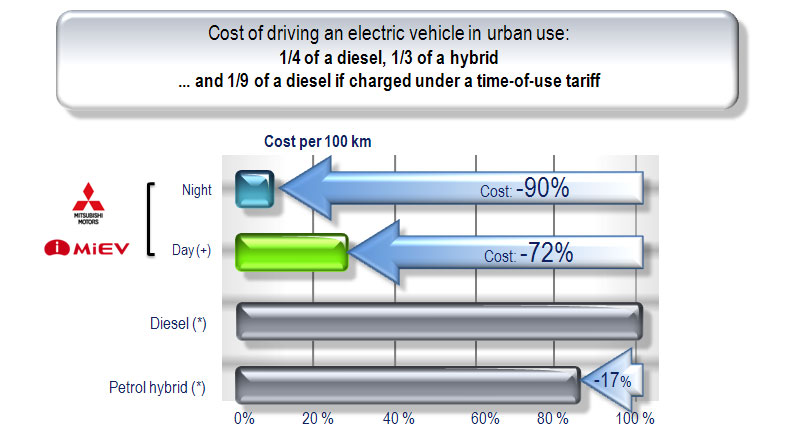
Figure 2: Electricity is a fraction of the price of fossil fuels
(*) Urban use: diesel 5 l/100 km (at EUR 1.33 per litre), hybrid 3.9 l/100 km (EUR 1.42 per litre), last resort tariff charging EUR 0,14 per KWh (source: vehicle manufacturers' official consumption figures, Endesa and author)
Car-to-grid power transmission and renewable energy optimisation
Electric cars have further efficiency strengths that translate into financial benefits. One of them is making better use of renewable energies. In Spain, wind turbines have to be turned off on many windy nights because there is nobody to consume the power they generate. We are literally wasting free energy. A fully charged electric car is loaded with 16 to 85 kWh of energy. This is sufficient power to supply a household for several days or an office for several hours. Electric cars could be charged at night with that renewable energy, and then plugged in to the electricity network the next morning for redistribution. This process is called V2G (vehicle to grid) and it is included in one of the project's working packs.
Project description: large-scale future simulation
Zem2all recreates the future scenario in which electric cars will be the norm to determine what will need to be in place by then.
A total of 200 standard cars have been replaced by electric cars equipped with tracking and data extraction components across a portion of Malaga province including Malaga city and the coastal area to Marbella. Additionally, 23 quick-charge posts (400 V DC) and 200 standard-charge posts (230 V AC) have been installed, and work is under way to set up an electric car monitoring centre and an energy monitoring centre.
Every user has a last-generation phablet to communicate with the project centres and other participants.
The trial is real in every sense. The cars, for instance, are not free of charge. The Mitsubishi i-MiEV are made available to participants under a rental scheme at a similar price as a conventional engine car in the same range. Charging posts, which are fitted at users' business facilities or homes, are also paid for, along with any installation work (which is sometimes simple and relatively low cost, and sometimes complex and expensive). Electricity is priced according to individual consumer contracts, with a quick charge (which allows travelling about 50 km) costing 6 EUR, as it is intended for emergency use only. Standard charging will be used for normal operation of the car both in the project and in the future.
The participants who have signed up are widely diverse: families, large and small businesses from a variety of industries, and public institutions, including public service providers and local governments.
When Zem2all reaches its end at the end of 2015, we will have found out for instance how many and what kind of quick-charge posts are actually used (even whether they are used at all), and what staff and technologies are needed to set up an electric car monitoring centre (and whether such a facility is indeed necessary or a computer can perform this role). At that point, the project will have laid the groundwork for the next stage in global electric mobility.
Online monitoring
The Zem2all website features online monitoring of the project. Among other information, we learn that data from more than 1.2 million km of electric car use by ordinary users has already been collected. This probably constitutes the largest data repository in the world on electric cars used in everyday situations.
The website also provides data on average speed and consumption across different areas of Malaga.
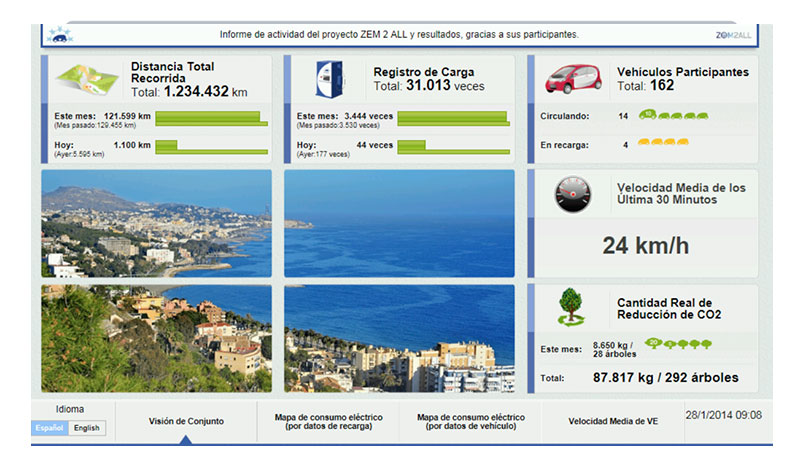
Figure 3: Instant current overview of the project

Figure 4: Map of available quick-charge stations and charging cars (one car charging at 3 kW in the town of Castañetas)
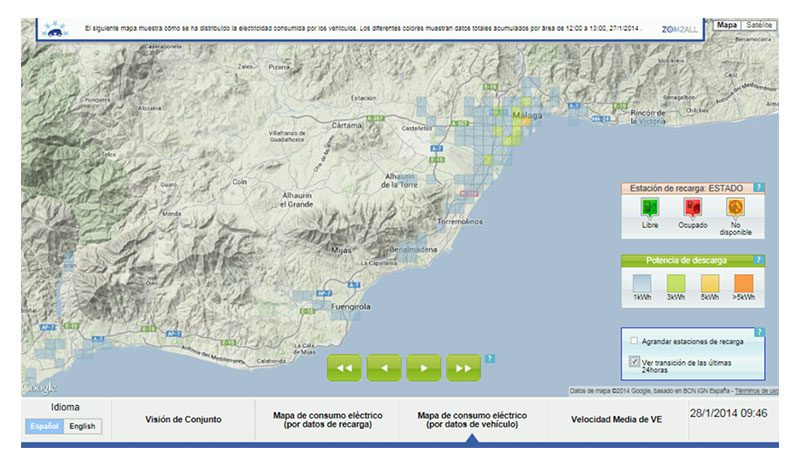
Figure 5: Energy use map based on data supplied by the on-board units mounted on the cars. The map shows energy use between 12:00 pm and 1.00 pm on 27 January. Most cars have used less than 1 kWh, some have used 3 kWh and one has used 5 kWh. This could be a case of vehicle-to-grid energy transfer (V2G), as its consumption is unusually high for city travel.
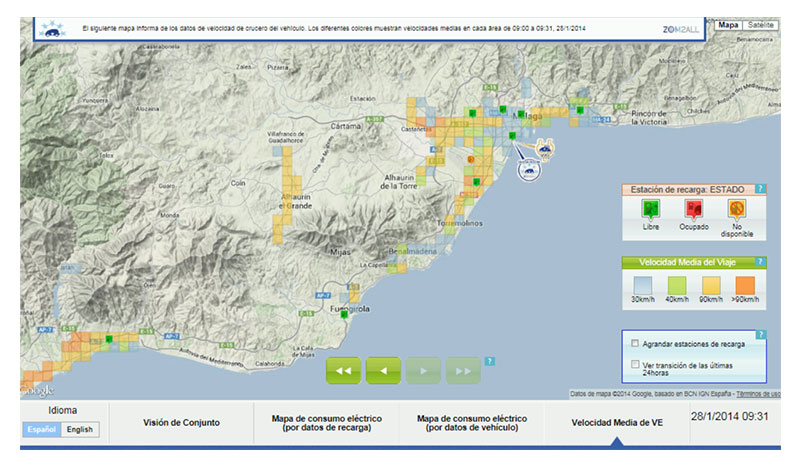
Figure 6: Average speed map based on data supplied by the on-board units mounted on the cars. This map shows that electric cars are driven at a full range of speeds, from 30 km/h in urban areas to more than 90 km/h on motorways.
MAPFRE's involvement
Zem2all is quite conventional as far as insurance is concerned: MAPFRE insures the vehicles, which participants obtain under a rental scheme. The firm has made an effort to take part in the project despite the uncertainties still surrounding the insurance of electric vehicles (although these have now been reduced thanks to the trials that MAPFRE's safety research centre CESVIMAP has been carrying out with electric cars for several years, including the Mitsubishi i-MiEV, which was the first model available). The present initiative will provide detailed information on the use of insurance services for electric cars.
An additional offshoot of Zem2all is a deal signed by MAPFRE, Mitsubishi Heavy Industries and Mitsubishi Corporation for joint study of the body of data collected from the participants, which is much larger than the data generated by active components on board conventional vehicles (such as those mounted on Ycar and ECOcar policy customers' cars). In fact, the companies have jointly designed a new on-board unit.
Cutting-edge research based on Zem2all with MAPFRE's involvement
The conclusions of this study will no doubt enable new insurance products to be developed and existing products to be fine-tuned. With such an extraordinarily rich body of information, MAPFRE will reassert its outstanding capabilities in usage-based insurance, including pay-as-you-drive (PAYD) and pay-how-you-drive (PHYD).
Mitsubishi's and MAPFRE's involvement in Zem2all will confirm the two companies' leadership in their respective industries. The results will become apparent in both corporate groups beginning in January 2016.


